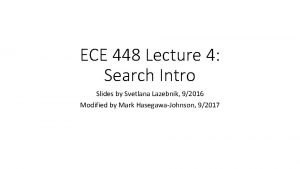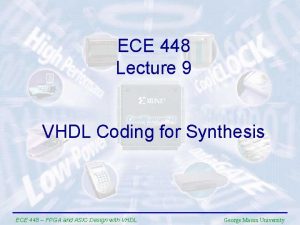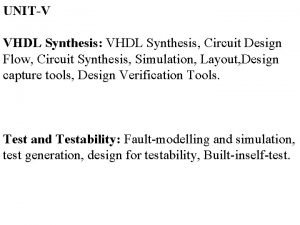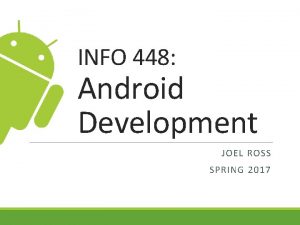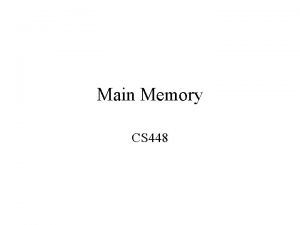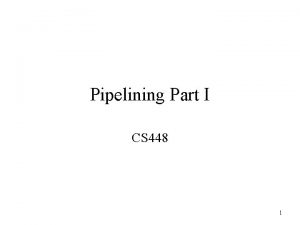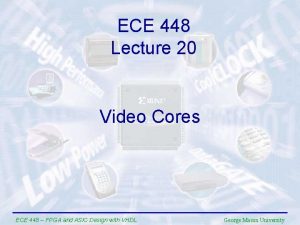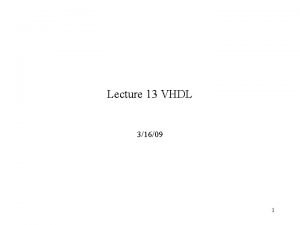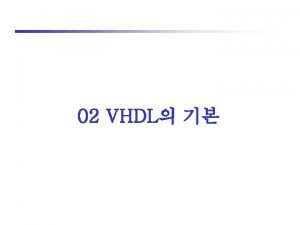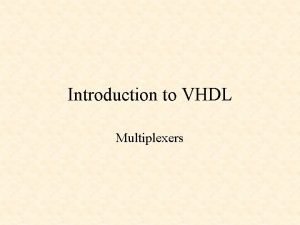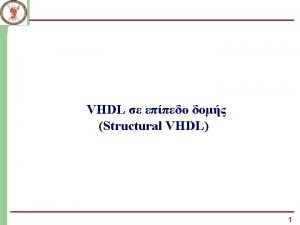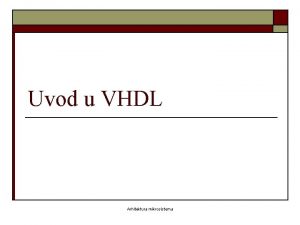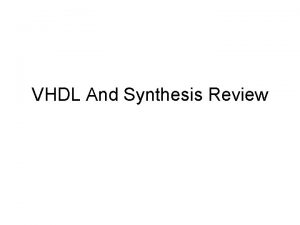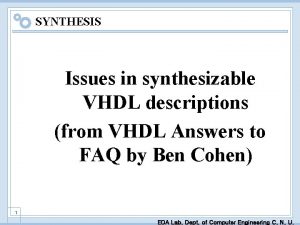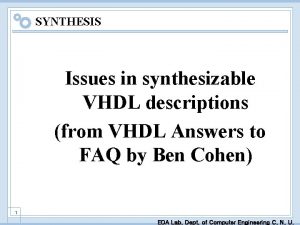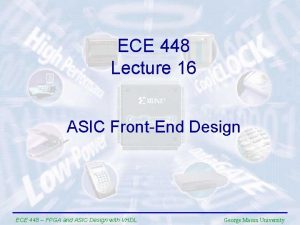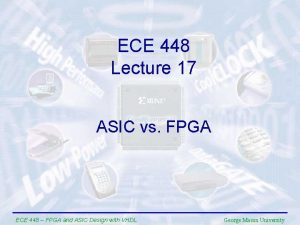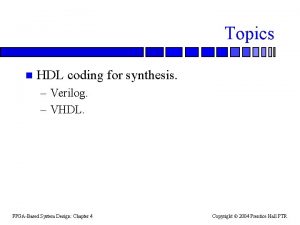ECE 448 Lecture 9 VHDL Coding for Synthesis











































- Slides: 43

ECE 448 Lecture 9 VHDL Coding for Synthesis ECE 448 – FPGA and ASIC Design with VHDL George Mason University

Required reading • S. Lee, Advanced Digital Logic Design, Chapter 4. 4, Synthesis Heuristics (handout) ECE 448 – FPGA and ASIC Design with VHDL 2

Non-synthesizable VHDL ECE 448 – FPGA and ASIC Design with VHDL 3

Delays are not synthesizable Statements, such as wait for 5 ns a <= b after 10 ns will not produce the required delay, and should not be used in the code intended for synthesis. ECE 448 – FPGA and ASIC Design with VHDL 4

Initializations Declarations of signals (and variables) with initialized values, such as SIGNAL a : STD_LOGIC : = ‘ 0’; cannot be synthesized, and thus should be avoided. If present, they will be ignored by the synthesis tools. Use set and reset signals instead. ECE 448 – FPGA and ASIC Design with VHDL 5

Reports and asserts, such as report "Initialization complete"; assert initial_value <= max_value report "initial value too large" severity error; cannot be synthesized, but they can be freely used in the code intended for synthesis. They will be used during simulation and ignored during synthesis. ECE 448 – FPGA and ASIC Design with VHDL 6

Floating-point operations Operations on signals (and variables) of the type real are not synthesizable by the current generation of synthesis tools. ECE 448 – FPGA and ASIC Design with VHDL 7

Dual-edge flip-flops PROCESS ( Clk ) BEGIN IF rising_edge(Clk) or falling_edge(CLk) THEN Q <= D ; END IF ; END PROCESS ; Dual-edge flip-flops and registers not synthesizable using FPGA tools ECE 448 – FPGA and ASIC Design with VHDL 8

Synthesizable VHDL ECE 448 – FPGA and ASIC Design with VHDL 9

Register Transfer Level (RTL) Design Description Combinational Logic … Registers ECE 448 – FPGA and ASIC Design with VHDL 10

VHDL Design Styles dataflow Concurrent statements structural behavioral Components and Sequential statements interconnects • Registers synthesizable • Shift registers • Counters • State machines and more if you are careful ECE 448 – FPGA and ASIC Design with VHDL 11

Combinational Logic Synthesis for Beginners ECE 448 – FPGA and ASIC Design with VHDL 12

Simple rules for beginners For combinational logic, use only concurrent statements • • concurrent signal assignment ( ) conditional concurrent signal assignment (when-else) selected concurrent signal assignment (with-select-when) generate scheme for equations (for-generate) ECE 448 – FPGA and ASIC Design with VHDL 13

Simple rules for beginners For circuits composed of - simple logic operations (logic gates) - simple arithmetic operations (addition, subtraction, multiplication) - shifts/rotations by a constant use • concurrent signal assignment ECE 448 – FPGA and ASIC Design with VHDL ( ) 14

Simple rules for beginners For circuits composed of - multiplexers - decoders, encoders - tri-state buffers use • conditional concurrent signal assignment (when-else) • selected concurrent signal assignment (with-select-when) ECE 448 – FPGA and ASIC Design with VHDL 15

Left vs. right side of the assignment Left side <= Right side <= when-else with-select <= • Internal signals (defined in a given architecture) • Ports of the mode - out - inout ECE 448 – FPGA and ASIC Design with VHDL Expressions including: • Internal signals (defined in a given architecture) • Ports of the mode - inout 16

Arithmetic operations Synthesizable arithmetic operations: • Addition, + • Subtraction, • Comparisons, >, >=, <, <= • Multiplication, * • Division by a power of 2, /2**6 (equivalent to right shift) • Shifts by a constant, SHL, SHR ECE 448 – FPGA and ASIC Design with VHDL 17

Arithmetic operations The result of synthesis of an arithmetic operation is a - combinational circuit - without pipelining. The exact internal architecture used (and thus delay and area of the circuit) may depend on the timing constraints specified during synthesis (e. g. , the requested maximum clock frequency). ECE 448 – FPGA and ASIC Design with VHDL 18

Operations on Unsigned Numbers For operations on unsigned numbers USE ieee. std_logic_unsigned. all and signals (inputs/outputs) of the type STD_LOGIC_VECTOR OR USE ieee. std_logic_arith. all and signals (inputs/outputs) of the type UNSIGNED ECE 448 – FPGA and ASIC Design with VHDL 19

Operations on Signed Numbers For operations on signed numbers USE ieee. std_logic_signed. all and signals (inputs/outputs) of the type STD_LOGIC_VECTOR OR USE ieee. std_logic_arith. all and signals (inputs/outputs) of the type SIGNED ECE 448 – FPGA and ASIC Design with VHDL 20

Signed and Unsigned Types Behave exactly like STD_LOGIC_VECTOR plus, they determine whether a given vector should be treated as a signed or unsigned number. Require USE ieee. std_logic_arith. all; ECE 448 – FPGA and ASIC Design with VHDL 21

Integer Types Operations on signals (variables) of the integer types: INTEGER, NATURAL, and their sybtypes, such as TYPE day_of_month IS RANGE 0 TO 31; are synthesizable in the range -(231 -1). . 231 -1 for INTEGERs and their subtypes 0. . 231 -1 for NATURALs and their subtypes ECE 448 – FPGA and ASIC Design with VHDL 22

Integer Types Operations on signals (variables) of the integer types: INTEGER, NATURAL, are less flexible and more difficult to control than operations on signals (variables) of the type STD_LOGIC_VECTOR UNSIGNED, and thus are recommened to be avoided by beginners. ECE 448 – FPGA and ASIC Design with VHDL 23

Addition of Signed Numbers (1) LIBRARY ieee ; USE ieee. std_logic_1164. all ; USE ieee. std_logic_signed. all ; ENTITY adder 16 IS PORT ( Cin X, Y S Cout, Overflow END adder 16 ; : IN : OUT STD_LOGIC ; STD_LOGIC_VECTOR(15 DOWNTO 0) ; STD_LOGIC ) ; ARCHITECTURE Behavior OF adder 16 IS SIGNAL Sum : STD_LOGIC_VECTOR(16 DOWNTO 0) ; BEGIN Sum <= ('0' & X) + Y + Cin ; S <= Sum(15 DOWNTO 0) ; Cout <= Sum(16) ; Overflow <= Sum(16) XOR X(15) XOR Y(15) XOR Sum(15) ; END Behavior ; ECE 448 – FPGA and ASIC Design with VHDL 24

Addition of Signed Numbers (2) LIBRARY ieee ; USE ieee. std_logic_1164. all ; USE ieee. std_logic_arith. all ; ENTITY adder 16 IS PORT ( Cin X, Y S Cout, Overflow END adder 16 ; : IN : OUT STD_LOGIC ; SIGNED(15 DOWNTO 0) ; STD_LOGIC ) ; ARCHITECTURE Behavior OF adder 16 IS SIGNAL Sum : SIGNED(16 DOWNTO 0) ; BEGIN Sum <= ('0' & X) + Y + Cin ; S <= Sum(15 DOWNTO 0) ; Cout <= Sum(16) ; Overflow <= Sum(16) XOR X(15) XOR Y(15) XOR Sum(15) ; END Behavior ; ECE 448 – FPGA and ASIC Design with VHDL 25

Addition of Signed Numbers (3) ENTITY adder 16 IS PORT ( X, Y S END adder 16 ; : IN : OUT INTEGER RANGE -32768 TO 32767 ; INTEGER RANGE -32768 TO 32767 ) ; ARCHITECTURE Behavior OF adder 16 IS BEGIN S <= X + Y ; END Behavior ; ECE 448 – FPGA and ASIC Design with VHDL 26

Addition of Unsigned Numbers LIBRARY ieee ; USE ieee. std_logic_1164. all ; USE ieee. std_logic_unsigned. all ; ENTITY adder 16 IS PORT ( Cin X, Y S Cout END adder 16 ; : IN : OUT STD_LOGIC ; STD_LOGIC_VECTOR(15 DOWNTO 0) ; STD_LOGIC ) ; ARCHITECTURE Behavior OF adder 16 IS SIGNAL Sum : STD_LOGIC_VECTOR(16 DOWNTO 0) ; BEGIN Sum <= ('0' & X) + Y + Cin ; S <= Sum(15 DOWNTO 0) ; Cout <= Sum(16) ; END Behavior ; ECE 448 – FPGA and ASIC Design with VHDL 27

Multiplication of signed and unsigned numbers (1) LIBRARY ieee; USE ieee. std_logic_1164. all; USE ieee. std_logic_arith. all ; entity multiply is port( a : in STD_LOGIC_VECTOR(15 downto 0); b : in STD_LOGIC_VECTOR(7 downto 0); cu : out STD_LOGIC_VECTOR(11 downto 0); cs : out STD_LOGIC_VECTOR(11 downto 0) ); end multiply; architecture dataflow of multiply is SIGNAL sa: SIGNED(15 downto 0); SIGNAL sb: SIGNED(7 downto 0); SIGNAL sres: SIGNED(23 downto 0); SIGNAL sc: SIGNED(11 downto 0); SIGNAL ua: UNSIGNED(15 downto 0); SIGNAL ub: UNSIGNED(7 downto 0); SIGNAL ures: UNSIGNED(23 downto 0); SIGNAL uc: UNSIGNED(11 downto 0); ECE 448 – FPGA and ASIC Design with VHDL 28

Multiplication of signed and unsigned numbers (2) begin -- signed multiplication sa <= SIGNED(a); sb <= SIGNED(b); sres <= sa * sb; sc <= sres(11 downto 0); cs <= STD_LOGIC_VECTOR(sc); -- unsigned multiplication ua <= UNSIGNED(a); ub <= UNSIGNED(b); ures <= ua * ub; uc <= ures(11 downto 0); cu <= STD_LOGIC_VECTOR(uc); end dataflow; ECE 448 – FPGA and ASIC Design with VHDL 29

Combinational Logic Synthesis for Intermediates ECE 448 – FPGA and ASIC Design with VHDL 30

Describing combinational logic using processes LIBRARY ieee ; USE ieee. std_logic_1164. all ; ENTITY dec 2 to 4 IS PORT ( w : IN En : IN y : OUT END dec 2 to 4 ; STD_LOGIC_VECTOR(1 DOWNTO 0) ; STD_LOGIC_VECTOR(0 TO 3) ) ; ARCHITECTURE Behavior OF dec 2 to 4 IS BEGIN PROCESS ( w, En ) BEGIN IF En = '1' THEN CASE w IS WHEN "00" => WHEN "01" => WHEN "10" => WHEN OTHERS => END CASE ; ELSE y <= "0000" ; END IF ; END PROCESS ; END Behavior ; ECE 448 – FPGA and ASIC Design with VHDL y <= "1000" ; y <= "0100" ; y <= "0010" ; y <= "0001" ; 31

Describing combinational logic using processes LIBRARY ieee ; USE ieee. std_logic_1164. all ; ENTITY seg 7 IS PORT ( bcd : IN STD_LOGIC_VECTOR(3 DOWNTO 0) ; leds : OUT STD_LOGIC_VECTOR(1 TO 7) ) ; END seg 7 ; ARCHITECTURE Behavior OF seg 7 IS BEGIN PROCESS ( bcd ) BEGIN CASE bcd IS -abcdefg WHEN "0000" => leds <= "1111110" ; WHEN "0001" => leds <= "0110000" ; WHEN "0010" => leds <= "1101101" ; WHEN "0011" => leds <= "1111001" ; WHEN "0100" => leds <= "0110011" ; WHEN "0101" => leds <= "1011011" ; WHEN "0110" => leds <= "1011111" ; WHEN "0111" => leds <= "1110000" ; WHEN "1000" => leds <= "1111111" ; WHEN "1001" => leds <= "1110011" ; WHEN OTHERS => leds <= "-------" ; END CASE ; END PROCESS ; END Behavior ; ECE 448 – FPGA and ASIC Design with VHDL 32

Describing combinational logic using processes LIBRARY ieee ; USE ieee. std_logic_1164. all ; ENTITY compare 1 IS PORT ( A, B : IN Aeq. B : OUT END compare 1 ; STD_LOGIC ; STD_LOGIC ) ; ARCHITECTURE Behavior OF compare 1 IS BEGIN PROCESS ( A, B ) BEGIN Aeq. B <= '0' ; IF A = B THEN Aeq. B <= '1' ; END IF ; END PROCESS ; END Behavior ; ECE 448 – FPGA and ASIC Design with VHDL 33

Incorrect code for combinational logic - Implied latch (1) LIBRARY ieee ; USE ieee. std_logic_1164. all ; ENTITY implied IS PORT ( A, B : IN Aeq. B : OUT END implied ; STD_LOGIC ; STD_LOGIC ) ; ARCHITECTURE Behavior OF implied IS BEGIN PROCESS ( A, B ) BEGIN IF A = B THEN Aeq. B <= '1' ; END IF ; END PROCESS ; END Behavior ; ECE 448 – FPGA and ASIC Design with VHDL 34

Incorrect code for combinational logic - Implied latch (2) A B ECE 448 – FPGA and ASIC Design with VHDL Aeq. B 35

Describing combinational logic using processes Rules that need to be followed: 1. All inputs to the combinational circuit should be included in the sensitivity list 2. No other signals should be included in the sensitivity list 3. None of the statements within the process should be sensitive to rising or falling edges 4. All possible cases need to be covered in the internal IF and CASE statements in order to avoid implied latches ECE 448 – FPGA and ASIC Design with VHDL 36

Covering all cases in the IF statement Using ELSE IF A = B THEN Aeq. B <= '1' ; ELSE Aeq. B <= '0' ; Using default values Aeq. B <= '0' ; IF A = B THEN Aeq. B <= '1' ; ECE 448 – FPGA and ASIC Design with VHDL 37

Covering all cases in the CASE statement Using WHEN OTHERS CASE y IS WHEN S 1 => Z <= "10"; WHEN S 2 => Z <= "01"; WHEN OTHERS => Z <= "00"; END CASE; CASE y IS WHEN S 1 => Z <= "10"; WHEN S 2 => Z <= "01"; WHEN S 3 => Z <= "00"; WHEN OTHERS => Z <= „--"; END CASE; Using default values Z <= "00"; CASE y IS WHEN S 1 => Z <= "10"; WHEN S 2 => Z <= "10"; END CASE; ECE 448 – FPGA and ASIC Design with VHDL 38

Sequential Logic Synthesis for Beginners ECE 448 – FPGA and ASIC Design with VHDL 39

For Beginners Use processes with very simple structure only to describe - registers - shift registers - counters - state machines. Use examples discussed in class as a template. Create generic entities for registers, shift registers, and counters, and instantiate the corresponding components in a higher level circuit using GENERIC MAP PORT MAP. Supplement sequential components with combinational logic described using concurrent statements. ECE 448 – FPGA and ASIC Design with VHDL 40

Sequential Logic Synthesis for Intermediates ECE 448 – FPGA and ASIC Design with VHDL 41

For Intermmediates 1. 2. 3. Use Processes with IF and CASE statements only. Do not use LOOPS or VARIABLES. Sensitivity list of the PROCESS should include only signals that can by themsleves change the outputs of the sequential circuit (typically, clock and asynchronous set or reset) Do not use PROCESSes without sensitivity list (they can be synthesizable, but make simulation inefficient) ECE 448 – FPGA and ASIC Design with VHDL 42

For Intermmediates (2) Given a single signal, the assignments to this signal should only be made within a single process block in order to avoid possible conflicts in assigning values to this signal. Process 1: PROCESS (a, b) BEGIN y <= a AND b; END PROCESS; Process 2: PROCESS (a, b) BEGIN y <= a OR b; END PROCESS; ECE 448 – FPGA and ASIC Design with VHDL 43
 Apa itu open coding
Apa itu open coding Contoh open coding axial coding selective coding
Contoh open coding axial coding selective coding Fpga software
Fpga software Vhdl asic
Vhdl asic Ece 448
Ece 448 Ece 448
Ece 448 Ece 448
Ece 448 Ece 448
Ece 448 Vhdl design flow
Vhdl design flow Axial coding vs open coding
Axial coding vs open coding Coding dna and non coding dna
Coding dna and non coding dna 01:640:244 lecture notes - lecture 15: plat, idah, farad
01:640:244 lecture notes - lecture 15: plat, idah, farad Joel ross uw
Joel ross uw Cs 448
Cs 448 500 - 448
500 - 448 Afsc 448 scmw saspo
Afsc 448 scmw saspo Cs 448
Cs 448 Jest głównym dopływem wisły ma 448 km długości
Jest głównym dopływem wisły ma 448 km długości Factors of 448
Factors of 448 Redogör för vad psykologi är
Redogör för vad psykologi är Bästa kameran för astrofoto
Bästa kameran för astrofoto Bra mat för unga idrottare
Bra mat för unga idrottare Ramsa geometriska former
Ramsa geometriska former Publik sektor
Publik sektor Upprepningar i prosa
Upprepningar i prosa Etik och ledarskap etisk kod för chefer
Etik och ledarskap etisk kod för chefer Vad kallas den mantel som bars av kvinnor i antikens rom
Vad kallas den mantel som bars av kvinnor i antikens rom Vilotidsbok
Vilotidsbok Orubbliga rättigheter
Orubbliga rättigheter Rita perspektiv
Rita perspektiv Iso 22301 utbildning
Iso 22301 utbildning Ministerstyre för och nackdelar
Ministerstyre för och nackdelar Jätte råtta
Jätte råtta Tillitsbaserad ledning
Tillitsbaserad ledning Plats för toran ark
Plats för toran ark Ro i rom pax
Ro i rom pax Nyckelkompetenser för livslångt lärande
Nyckelkompetenser för livslångt lärande Mästare lärling modell
Mästare lärling modell Shingelfrisyren
Shingelfrisyren Matematisk modellering eksempel
Matematisk modellering eksempel Cks
Cks Verktyg för automatisering av utbetalningar
Verktyg för automatisering av utbetalningar Shivaiter
Shivaiter Cellorov
Cellorov




